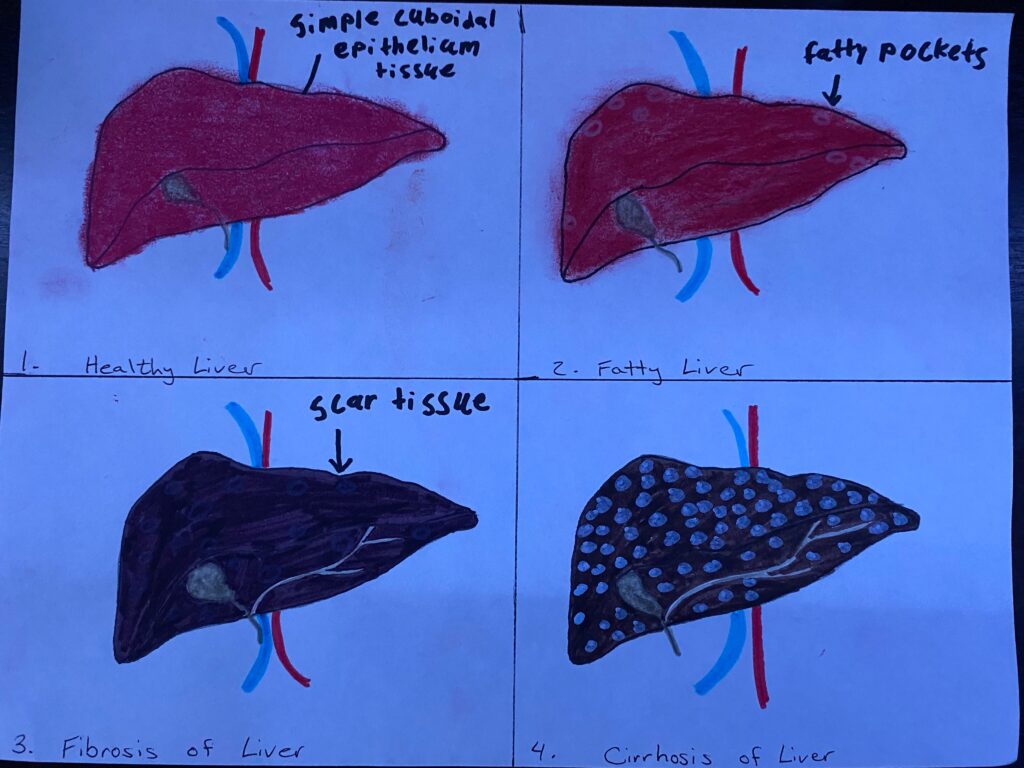For my STEAM Project I just made a poster of the 4 stages of cirrhosis and how the tissue of the liver changes throughout each stage.
Course objective: Describe function & location of various tissues also describe in depth epithelium & connective tissue
For my STEAM Project, I chose to do how cirrhosis of the liver changes the simple cuboidal epithelium tissue that the liver is composed of. My project covers the objective. Describe in depth each epithelial and connective tissue. Being able to describe their function and location also states the location of the various tissues in the body. The type of tissue the liver is made up of is simple cuboidal epithelium tissue, a single-layer cell involved in secretion and absorption, which goes hand in hand with the function of the liver. The liver regulates most chemical levels in the blood and excretes a bile product. This helps carry away waste products from the liver. All the blood leaving the stomach and intestines passes through the liver. The liver processes this blood, breaks down balances, creates the nutrients, and metabolizes drugs into forms that are either easier to use for the rest of the body or nontoxic. The liver’s waste leaves our body through our feces. The liver is a filter that goes in hand with the function of the tissue it is made of. This type of tissue is located in a couple of different locations throughout the body, like in the kidney tubules, ducts, secretory portions of small glands, and the ovary surface.
What is Cirrhosis? Cirrhosis is a condition in which your liver is scarred and permanently damaged. Scar tissue replaces healthy liver tissue and prevents your liver from working usually. Scar tissue also partially blocks the flow of blood through your liver; as the stages of cirrhosis get worse, your liver begins to fail. Most people do not even know they have cirrhosis since signs or symptoms do not show until their liver is badly damaged. There are four stages to cirrhosis; stage 1 is called steatosis. Steatosis is the first stage of liver disease and is inflammation of the bile duct or liver. As the body strives to fight against the disease or infection, abdominal discomfort is frequently the first symptom of inflammation; if this inflammation is not managed, it can cause damage to the liver, exacerbating the illness. Stage 2 is fibrosis or scarring of the liver due to the inflammation not being treated. In this stage, due to the high inflammation, the simple cuboidal epithelium tissue is starting to be replaced with scar tissue which will begin to obstruct natural blood flow to the liver; this causes the liver to be unable to function correctly, but with treatment, the liver may still be capable of recovering, avoiding more damage, and slowing the progression of the liver disease. Stage 3 is cirrhosis of the liver. Cirrhosis develops due to the advancement of liver disease, mainly due to lack of therapy, in which scar tissue replaces good tissue in the liver. This process occurs when a progressive illness or infection destroys healthy liver cells over time (often several years). This causes permanent scarring of the liver, causing it to become stiff and lumpy. The liver will eventually be unable to function because the growing scar tissue will make blood flow through the portal vein
and into the liver impossible. Lastly, stage 4 is liver failure. Failure of the liver will signify the end of liver functioning. This will need quick medical attention to avoid death.
Learning from this project, is that cirrhosis changes the simple cuboidal epithelium tissue of the liver to scar tissue from the high inflammation which will restrict the blood flow to the liver having very negative effects to the body including death.

